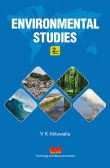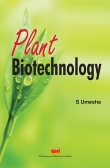Bioanalytical Techniques
Book Details
Bioanalytical Techniques form an integral part of applied biology and biomedical sciences. The book provides understanding of the concept and working principles of various bioanalytical techniques used in biomedical sciences, environmental studies, life sciences, pharmaceutical analysis, molecular biology, and biotechnological research, as well as the various instruments used in these processes. Divided into 12 chapters, the book provides a comprehensive account of microscopy, centrifugation, chromatography, electrophoresis, spectroscopy. It also focuses on two main topics: radioisotope and immunodiagnostic techniques. Techniques in molecular biology and recombinant DNA technology have also been described in detail.
Key Features
- Explains analytical instrumentation in a concise manner
- Provides state-of-the-art sophisticated techniques that would be beneficial to researchers in various fields for experimentation
- Encourages reader to analytical thinking and practical application of the technique
Target Audience
-
Graduate and Postgraduate students, Researchers, Academicians, and Professionals in the fields of Environmental Studies, Chemistry, Analytical Chemistry, Biomedical Science, Pharmacy, Bioanalysis, Serology, Pharmaceutical Chemistry, Pharmaceutical Analysis, Pharmaceutics and Medicinal Chemistry; Biotechnology, Toxicology; analytical scientists in government, pharmaceutical industry and biotechnology industry and regulatory agencies.
Table of Contents
1. GENERAL PRINCIPLES OF ANALYTICAL INSTRUMENTATION
1.1 Introduction
1.2 Experimental Studies
1.3 Experimental Errors
1.4 Statistical Parameters for Validation of an Experiment
2. SOLUTIONS AND BUFFERS
2.1 Introduction
2.2 Units of Concentration
2.3 The Concept of pH
2.4 Acids and Bases
2.5 Henderson–Hasselbalch Equation
2.6 Determination of pKa
2.7 Buffers
3. MICROSCOPY
3.1 Historical Background
3.2 Nature of Light
3.3 Compound Microscope
3.4 Image Formation in a Light Microscope
3.5 Phase Contrast Microscopy
3.6 Fluorescence Microscopy
3.7 Electron Microscopy
4. CELL DISRUPTION
4.1 Introduction
4.2 Barriers for Cell Disruption
4.3 Methods of Cell Disruption—an Overview
4.4 Mechanical Methods of Cell Disruption
4.5 Non-Mechanical Methods of Cell Disruption
4.6 Combinations of Cell Disruption Methods
4.7 Selection of Cell Disruption Methods
4.8 Analysis of Cell Disruption
5. CENTRIFUGATION
5.1 Introduction
5.2 Principles of Centrifugation
5.3 Centrifuge Machines
5.4 Centrifugal Separations
5.5 Analytical Ultracentrifugation
5.6 Care and Safety of Centrifuges
6. CHROMATOGRAPHIC TECHNIQUES
6.1 Introduction
6.2 Types of Chromatographic Techniques
6.3 Planar Chromatography
6.4 Column Chromatography
6.5 Protein Purification Strategies
7. ELECTROPHORESIS
7.1 Introduction
7.2 Principles of Electrophoresis
7.3 Free Solution Electrophoresis
7.4 Paper Electrophoresis
7.5 Gel Electrophoresis
7.6 Gel Electrophoresis of Proteins
7.7 Gel Electrophoresis of Nucleic Acids
7.8 Capillary Electrophoresis
8. SPECTROSCOPY I
8.1 Electromagnetic Radiations
8.2 Ultraviolet and Visible Light Spectroscopy
8.3 Fluorescence Spectroscopy
8.4 Atomic Absorption Spectrometry
8.5 X-ray Spectroscopy
8.6 Circular Dichroism and Optical Rotatory Dispersion
9. SPECTROSCOPY II
9.1 Introduction
9.2 Infrared Spectroscopy
9.3 Nuclear Magnetic Resonance Spectroscopy
9.4 Electron Spin Resonance Spectroscopy
9.5 Mass Spectroscopy
10. RADIOISOTOPE TECHNIQUES
10.1 Introduction and Applications
10.2 Structure of Atom and Radioactivity
10.3 Types of Radioactive Decay
10.4 Interaction of Radioactivity with Matter
10.5 Kinetics of Radioactive Decay
10.6 Units of Radioactivity
10.7 Detection and Measurement of Radioactivity
10.8 Safety Issues and Radio-waste Management
11. IMMUNOCHEMICAL TECHNIQUES
11.1 Introduction
11.2 Production and Purification of Antibodies
11.3 Immunoassay Techniques
11.4 Advances in Immunochemical Techniques
12. MOLECULAR BIOLOGY TECHNIQUES
12.1 Introduction
12.2 Isolation of Nucleic Acids
12.3 Qualitative and Quantitative Evaluation of Nucleic Acids
12.4 Nucleic Acid Hybridization
12.5 Restriction Digestion
12.6 Nucleic Acid Sequencing
12.7 DNA Amplification by Polymerase Chain Reaction
Keywords
You may also like...
-
 Environmental Studies (Second Edition)
Regular Price 325.00
Special Price 293.00
Environmental Studies (Second Edition)
Regular Price 325.00
Special Price 293.00
-
 The Land of the Setting Sun & Other Nature Tales
Regular Price 250.00
Special Price 225.00
The Land of the Setting Sun & Other Nature Tales
Regular Price 250.00
Special Price 225.00
-
 Plant Biotechnology
Regular Price 795.00
Special Price 715.00
Plant Biotechnology
Regular Price 795.00
Special Price 715.00
-
Microbial Genetics Regular Price 550.00 Special Price 495.00


